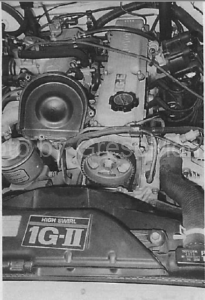1985 year model Toyota · crown model: E-GS 120 engine model: 1G-EU (gasoline engine) transmission: 4AT mileage: 22,000km
Goods receipt by vehicle inspection request. By the way, the average mileage is 1,400 km / year.

Because the annual mileage is about 1,500 km from the past maintenance history, engine oil change once every 2 years, engine auxiliary machinery such as V belt etc are exchanged about every 5 years considering aged deterioration etc. Although it says, the user says “I want you to raise it as cheaply as possible.” Still, “At the very least, it is better to inspect the brakes and to replace brake fluid, engine oil, oil elements.”
Even though the annual mileage is small, even though the oils and fats that have not been exchanged for two years have not leaked, it is doubtful as to how the ingredients play a role. Explanation that there is a possibility that the component may have been altered by the oxidizing action and acknowledged with the above-mentioned car inspection contents.
A user who got on a car gave me a message saying, “By the way, apparently there seems to be no power at this time, so please take a look.”
I was a little surprised. Even if it is easy to say that the old car of the 85-year style “power has gone” now, … it was said that it was said that it will raise the vehicle inspection cheaply before that, so I was in trouble. Unlike troubles such as stalling or not starting the engine, this is a talk at a sense level that only the user himself knows. On the contrary, if you say “I saw this, but this is something like this,” the car itself can run without problems so it’s about the level where I can do it.
When I go to trial operation, I feel that the engine is blowing badly. The idling is stable and the shift up of the AT mission is no problem, but it feels somewhat heavy. Although it runs as it is when stepping on the accelerator, there is no fat torque feeling in the low speed range which is the engine characteristic of this 1 G system. It seems likely that this is what the user was told.
We decided to go on maintenance work and try turning on the diagnosis, but this type is not a T – E 1 short circuit, it is an old yellow quadrupole coupler and materials of Diagnosis can be obtained because it is too old There was not.
Still it was set so that the engine check lamp lights up in the instrument panel monitor when the engine breaks down, so when I asked the user whether it lighted up or not, it was said that it never lighted up. That means that sensors and actuators of the ECU and other electrical systems are considered normal.
I decided to check the three elements (compression, spark, fuel) which are the basis of the internal combustion engine. Even if it inspects, considering the order, it takes time and labor only if you do not set it well.
I decided to start from the fuel system. Although it may be normal even if it sees from the condition that the partial damper goes up, it is normal value to check the fuel pressure by attaching the fuel pressure gauge just in case.
Although compression is next, although it seems to be okay with compression missing even from the engagement condition of the engine and the number of mileage runs, I measured it at the time of checking the spark plug, but there is still no problem.
In the ignition system (spark) I wanted to replace the spark plug, but was to say that it was as cheap as possible, so checked visually and cleaned and reassembled as there was no abnormality. Since the continuity of the plug cord is also normal, I decided to check the ignition timing (valve timing), but what was the timing tight used for inspection had broken down.

For that reason, we decided to take a look at the “deviation” of the valve timing. Since this 1 G engine comes off only the upper cover of the timing cover, the inspection is easy. Looking at the position of the crank pulley and the cam shaft, there is a deviation of one mountain, or there is play with playing. Moreover, when I touched the timing belt I went off to the front. Normally, when replacing with a new belt, it is a belt that should be hard to enter even if the tensioner is fully loosened. It is evidence that that it moves out and is so relaxed.
Remove the sealing plug of the tensioner adjustment bolt on the timing belt cover, loosen the bolt, and adjust the tension of the timing belt again. Then, there was no play, and there was no gap. When tried running as it was, the feeling changed obviously, the engine began to rush lightly.
After all the car inspection and maintenance was over, after the car delivered, the user gave me a word of compliment that the power was “resurrected, I was happy to leave the vehicle inspection.”
Actually it was not getting better as a result of a car inspection, it is a deviation of the ignition timing caused by a deviation in valve timing. In the era when the point type distributor was mainstream in the ignition system, it was the inspection of the ignition timing which had been done as a matter of course, but there is no plug cord etc in the present full transistor type ignition system. It is natural that it can not be inspected without a timing light but a special equipment, but because of the structure of the same gasoline engine, the basic is the same, so the basics of its maintenance are the same. It was a case that he kept in mind that he would like to engage in maintenance work carefully from the usual basis.